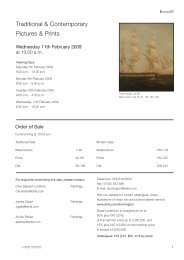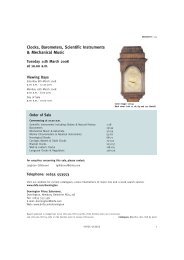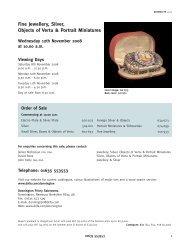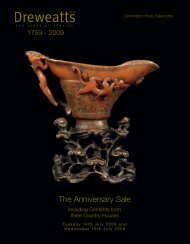Donnington Priory Salerooms
Donnington Priory Salerooms
Donnington Priory Salerooms
You also want an ePaper? Increase the reach of your titles
YUMPU automatically turns print PDFs into web optimized ePapers that Google loves.
86<br />
A George III small pantry timepiece<br />
Edward Smith, Newbury, circa 1800<br />
The thirty-hour four-pillar movement with verge escapement<br />
and 4.5 inch single-sheet brass Roman numeral break-arch<br />
dial signed EDW’D SMITH, NEWBURY to arch, now in a<br />
simple stained pine box-form case, (lacking alarm, later<br />
hands), 16cm high.<br />
£400-600<br />
87<br />
A Dutch marquetry Hague clock<br />
Unsigned, late 17th century and later<br />
The movement with four baluster-turned pillars pinned through<br />
the backplate, the extant single tandem spring drum with two<br />
great wheels driving both going and striking trains with outside<br />
countwheel, elaborate pierced steel gate and later anchor<br />
escapement, (the quarter train lacking), the movement now<br />
suspended from a 13.75 inch square white painted Roman<br />
numeral dial hinged to the case on the left hand side, with<br />
elaborate pierced and engraved brass hands and four-seasons<br />
cast spandrels, the pedimented case with parquetry-star behind<br />
movement to interior, and foliate trail decorated tympanium<br />
above conforming shallow entablature and swollen Corinthian<br />
columns with rectangular plinths flanking dial to exterior, the rear<br />
with original iron hanging loops, 54cm high.<br />
The movement of the current lot, although incomplete, basically<br />
dates to around 1680. The tandem barrel was often utilised by<br />
Dutch makers at this period but was phased out in favour of the<br />
fusee by the last decade of the century. The original dial would<br />
have been velvet covered and applied with a pierced brass<br />
chapter ring and decorative spandrels. The rear ‘box’ of the<br />
case may possibly be original to the movement and retains early<br />
features such as the iron hanging loops and parquetry star<br />
panel to the interior. The current white painted dial and ‘facade’<br />
of the case probably date to the end of the 18th century.<br />
£500-700<br />
01635 553553<br />
86<br />
88<br />
A hooded wall clock with eight inch dial<br />
Thomas Guluan, Horsemonden circa 1730, the case<br />
later<br />
The 30-hour posted countwheel bell-striking movement<br />
with anchor escapement and 8 inch square brass dial<br />
signed Thos. Guluan, Horsemonden to the foliate-scroll<br />
engraved centre within an applied silvered Roman numeral<br />
chapter ring with cruciform half-hour markers and mask<br />
and scroll cast spandrels to angles, now in a shallow-arch<br />
pedimented case with foliate pierced fret above integral<br />
columns to hood with shaped apron and side sections to<br />
the bracket beneath, 53cm high.<br />
£800-1,200<br />
43<br />
87<br />
88






